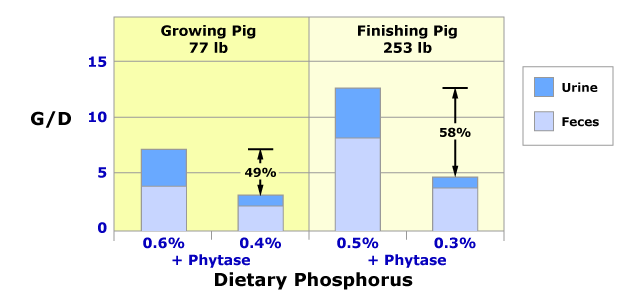|
|
 |
| Welcome | Getting Started | Resources | Site Map |
Week 10
Swine |
Instructions for listening to audio clips
- Download the QuickTime Player to listen to the audio files.
- Read the QuickTime Instructions for installation help.
- Download the RealPlayer to listen to the audio files
- Instructions are on the RealPlayer download page
Feed Additives
Follow along with the audio...
- Added to ration usually because of positive effect on growth rate
- Four main categories:
- Antimicrobial agents (antibiotics, chemotherapeutics)
- Anthelmintics (dewormers…internal & external parasites)
- Zn, Cu = promote growth at supraphysiological levels
- Enzymes = generally increase bio-availability of nutrient
Feed Additives: Antibiotics
- Used because:
- They improve growth rate and feed efficiency
- Reduce mortality
- Low levels = growth promotion
- Moderate levels = prevents disease in exposed animals
- High levels = treating disease
Antibiotics in Breeding Feed
Control |
Antibiotic |
|
|---|---|---|
Farrowing Rate,
% |
75.4 |
82.1 |
Live Pigs/Litter |
10.0 |
10.4 |
Antibiotics in Farrowing and Lactating Feed
Control |
Antibiotic |
|
|---|---|---|
Survival, % |
84.9 |
87.1 |
Avg Weaning Wt,
lb |
10.23 |
10.34 |
Feed:Gain
Antibiotic |
Cu |
Zn |
|
|---|---|---|---|
Starter |
6.9% |
9.7% |
4.8% |
Grower |
4.5 |
3.6 |
|
Finisher |
2.2 |
2.5 |
- P Additive effect of antibiotics and Cu
- 14% improvement in feed:gain ratio
- 250 PPM Cu, 3000 PPM Zn
Segregated Early Weaning
- Wean about 2 weeks
- Pigs are separated before their immune system becomes activated
- SEW pigs having low antigen challenge backgrounds gain weight extremely rapid
- Facilities must be extremely clean
Feed Additives: Enzymes
- Phytase is the most effective enzyme
- Phytase degrades phytate P found in cereal grains thus making the P more available to swine
- Can dramatically reduce the amount of P excreted in manure
- Phytase represents an important management tool to control environmental impact of large confinement operations

| |
| Welcome | Getting Started | Resources | SiteMap |